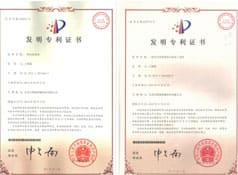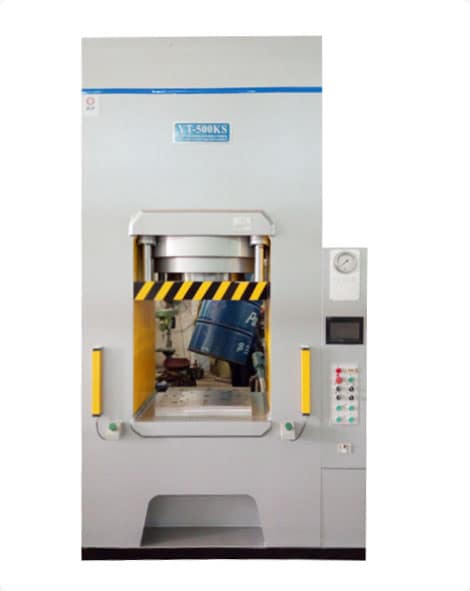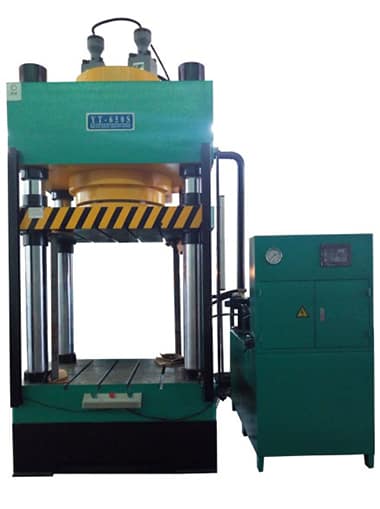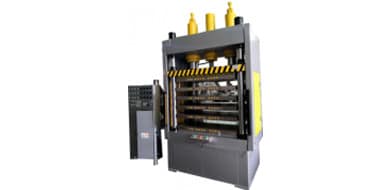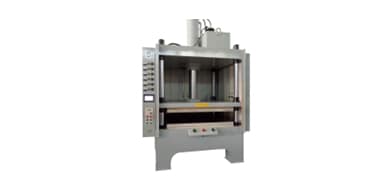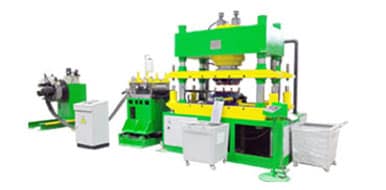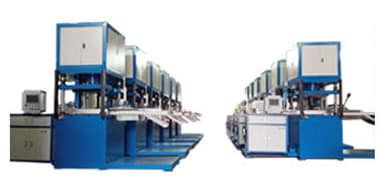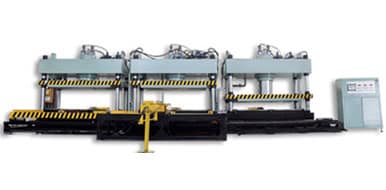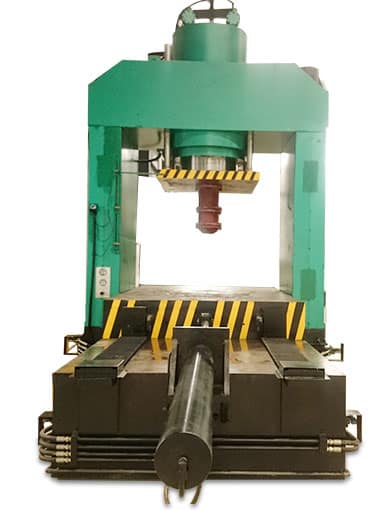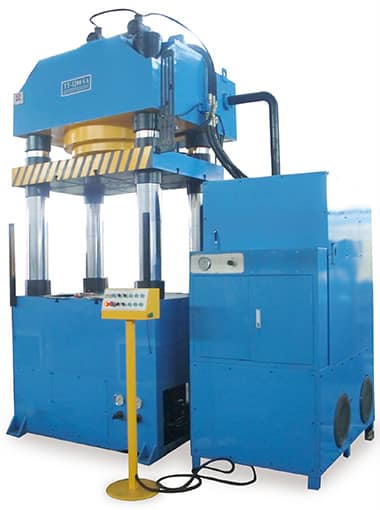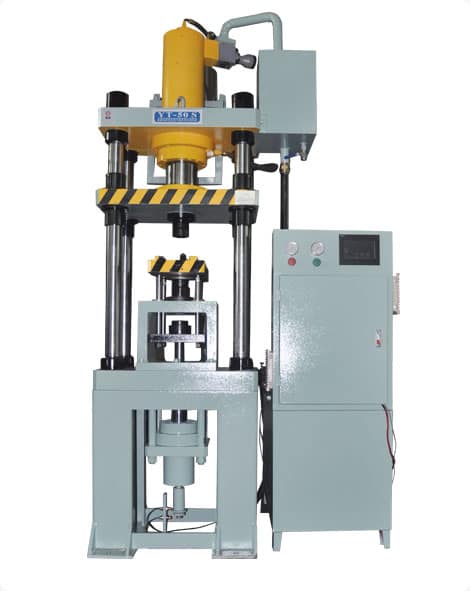How Much Does a Hydraulic Press Weigh?
time:2023-10-02 views:(点击 925 次)
Hydraulic presses are versatile tools used for many different tasks, including metal forming, deep drawing, clinching, staking, punching and blanking.
Hydraulic presses consist of two primary parts, including an H or C frame and table or bolster. Depending on the model chosen, either part may be moveable.
Size
Hydraulic presses are powerful machines that utilize hydraulic fluid to generate immense forces, which then transfers to pistons or other workpieces to complete various tasks. Hydraulic presses have numerous industrial uses such as metal forming, plastics/composite forming, abrasive wheel formation and pressing bearings into place (press fit).
Hydraulic presses offer many advantages over their mechanical counterparts. Notably, they're quieter and require less maintenance due to fewer moving parts - meaning fewer incidents of injury or breakdowns for users and higher capacities compared to mechanical ones of similar sizes.
Hydraulic presses boast greater precision than other forms of machinery in terms of precise control. Their ram force, direction, release of force and pressure dwell time settings can all be tailored precisely to a task for maximum precision and ensuring an operator can achieve his/her desired results.
Hydraulic presses offer several distinct advantages over mechanical presses when it comes to quick and easy adjustment for new jobs or materials. Furthermore, these hydraulic machines can handle heavy-duty tasks without the same degree of maintenance required for other machine tools due to fewer moving parts requiring oil lubrication; all remaining moving parts being fully protected against friction via pressurized oil flows.
Hydraulic presses typically consist of two cylinders separated by a bed or table and designed to produce compressive force to drive an anvil or die. However, the main distinction between hydraulic and conventional mechanical presses lies in their use of hydraulic fluid as opposed to electric power for their cylinders' driving mechanism.
A hydraulic press may come in various shapes and sizes depending on its weight and tasks it will perform. While stability and durability should be key considerations when choosing an ideal size for any hydraulic press, portability and space requirements also should be taken into account as well as frequency/intensity of operations performed so as to ascertain if a heavier or lighter press may be more suited.
Power
Hydraulic presses use a pump to force oil through a cylinder connected to a piston or metal ram, producing pressure that exceeds 20 times greater than any force you could apply manually. With such immense force behind them, hydraulic presses can perform various tasks, including bending and shaping thick metal plates, stamping sheet metal stamps, deep drawing blanking molding.
Heavy hydraulic presses generate more force, an essential factor when performing precision or delicate work. Furthermore, heavier presses tend to be more stable during operation - helping ensure safety and accuracy for operators as well as protecting equipment or parts from damage.
Hydraulic presses boast the advantage of quickly and precisely adapting to different tasks, providing rapid adaptation to changing job requirements. If a part needs high impact energy for creation, the hydraulic press can quickly and precisely be tuned up to deliver this force while mechanical presses may require time-consuming modifications for similar results.
Hydraulic presses typically offer lower maintenance costs than mechanical presses due to having fewer moving parts and being fully lubricated in a continuous flow of pressurized oil. They're less likely to break down, though when they do they usually fail due to minor causes like worn valves or pistons.
Hydraulic presses may be safer than mechanical presses if proper precautions are taken, however it's still essential to remember that they're industrial machines and should be treated as such. When operating any hydraulic press, be sure to read and abide by its manufacturer's guidelines, taking note of any additional safety measures as necessary and never touching moving parts while it's running; touching any moving part could result in serious injuries; check power source before performing repairs or maintenance as well as closing safety door before starting it up again for added protection!
Stability
Hydraulic presses are large machines used across industries including metalworking, manufacturing and construction. Hydraulic fluid transfers force between pistons to produce immense mechanical pressure that is used to shape or mold materials.
Hydraulic presses are typically constructed of heavy-duty steel frames to withstand the immense amounts of pressure they generate, and their hydraulic system is responsible for creating force needed to press materials - typically including a hydraulic pump, cylinders, valves and hoses - along with being manually, pneumatically or electrically operated to generate different amounts of force for different applications.
Hydraulic presses not only allow users to adjust the amount of force produced, but they also permit adjusting pressure throughout the length of a press stroke for greater flexibility and opens up new pressing applications. A hydraulic press also has fewer moving parts than mechanical ones which reduce safety issues as well as maintenance costs; plus they're significantly quieter without needing noise reduction equipment to manage loud noises.
When purchasing a hydraulic press, it is crucial that you consider its maximum load capacity. This will ensure it can accommodate both material dimensions and intended applications as well as your frequency and intensity of operations - for continuous or intense work you may require heavier hydraulic presses to avoid equipment failure or damage.
If you are considering purchasing a hydraulic press, it is crucial that you understand what materials and their thickness you will be working with, along with how much pressure will be used; this information will enable you to select an appropriate press size. A hydraulic press can perform various tasks including cutting, punching, forming, drilling, straightening and molding and is therefore an invaluable asset in any shop or factory environment.
Durability
Hydraulic presses differ from other machines by having fewer moving parts and typically being quieter, meaning there's less risk of someone getting injured and less maintenance/repair expenses required for them. But that doesn't make them less powerful - their force is controlled by a pump - be it manual, pneumatic, or electric - which creates a fixed pressure which determines its force (rated in tons). When powered up, that pressure transfers directly to the ram cylinder which then presses against material being pushed against.
Hydraulic presses can be utilized for many different tasks, from metal fabrication to vehicle repair. While they're most suited to jobs requiring force - like bending thick metal plates - hydraulic presses can also be utilized for more delicate jobs that require precision and symmetry.
Your choice of hydraulic press will depend on both the task at hand and available space in your workshop. There are various models to consider, including H frame presses, C frame presses and bench presses; each provides advantages and drawbacks, so be sure to select one which best meets your requirements.
Another factor to keep in mind when selecting a hydraulic press is its maximum load capacity. A heavy press can handle more pressure, making it more suitable for jobs requiring high levels of force. Furthermore, heavier presses tend to be more stable, which reduces risks such as tipping over or moving during operation.
If you need assistance choosing the ideal hydraulic press for your business or home, there are various online resources that can assist in selecting one. From manufacturers lists and product comparisons to reviews on individual items before making your choice, these sites provide invaluable assistance in making an informed choice.
Not only should you compare features, but you should also carefully evaluate each hydraulic press's price tag. Be mindful not to overspend; remember to account for additional costs like installation and shipping when making your choice.
Link to this article: https://www.ihydraulicpress.com/nsn/4939.html
Hot Articles
-
How to Make a Pizza With a Hydraulic Press
Hand tossing pizza can be quite an arm workout for your staff, which is why having a pizzeria dough press can be so useful. Commercial pizza presses……
-
How Much Money Does the Hydraulic Press Channel Make on YouTube?
The Hydraulic Press Channel is an extremely addictive YouTube series featuring man crushing objects with hydraulic presses. Watching these videos ……
-
How to Make Hydraulic Press Pocket Super-Viral Videos
After his video went viral, Vuohensilta’s workshop quickly became a draw for visitors looking to experience the thrill of having objects cru……
-
Hydraulic Press Channel
The Hydraulic Press Channel (HPC) is a YouTube series about crushing objects with hydraulic presses. Launched in October 2015 by Finnish factory own……
-
Hydraulic Presses and Their Safety Hazards
Hydraulic presses are powerful tools, designed to accomplish various industrial purposes. Their hydraulic fluid-powered mechanisms generate immense ……
-
How to Make a Hydraulic Press at Home
For workshops that need to apply huge pressure, hydraulic presses are indispensable tools. Instead of spending the money to purchase one commerciall……
-
Hydraulic Press Channel – How Much Does the Hydraulic Press You Tube Channel Make?
The Hydraulic Press Channel on YouTube publishes videos showing various objects being crushed using hydraulic presses. Established by Finnish fact……
-
How to Make an Electric Hydraulic Press
Hydraulic presses are useful metal-forming machines used in factories for fabrication, assembly and maintenance purposes. They use a pump to generat……
Latest News
-
How to Make a Small Hydraulic Press
Shopping can be challenging, particularly for something as complex and expensive as a hydraulic press. Such large purchases require much considera……
-
How Much Force Can a Hydraulic Press Produce?
Hydraulic presses are widely utilized for industrial uses, including metal forming. Their design uses an ingenious principle: pressure applied any……
-
How to Make Manual Hydraulic Press
When mallets or hammers won’t do the trick, hydraulic presses may be your go-to solution. These powerful workshop machines can apply an imme……
-
How to Make Hydraulic Shop Press
Hydraulic presses are essential tools in any metal fabrication, machining or auto shop. Their strong hydraulic systems are capable of compressing ev……
-
Can You Make a Diamond With a Hydraulic Press?
Diamonds may be known for being one of the hardest materials on Earth, but that doesn’t make them indestructible. Brittle materials like dia……
-
How to Make Hydraulic Press Project Safe
Hydraulic presses use hydraulic fluid to produce and transfer force, making it suitable for metalworking, manufacturing, construction and more. Hydr……
-
Hydraulic Press YouTube Channel
Lauri Vuohensilta owns and operates a factory in Finland and decided to experiment with his hydraulic press on everyday objects, creating videos sho……
-
How Much Does Hydraulic Press Channel Make?
Since Lauri Vuohensilta started posting videos of himself crushing random objects with a hydraulic press, his channel has experienced incredible p……


